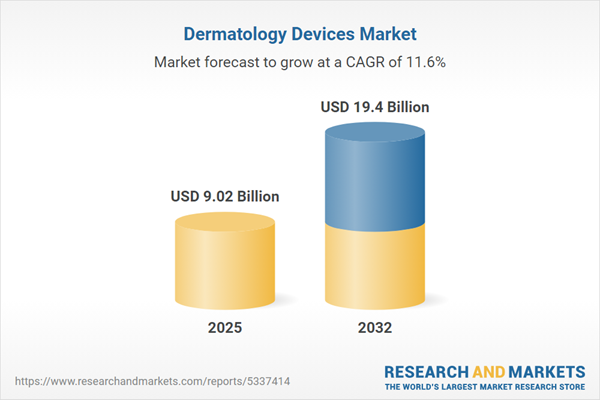Speak directly to the analyst to clarify any post sales queries you may have.
The dermatology devices market is experiencing swift technological evolution, expanding its relevance across clinical and aesthetic healthcare. Decision-makers in medtech, healthcare delivery, and investment must closely monitor emerging treatment technologies, segmentation trends, and regional shifts influencing this sector.
Market Snapshot: Dermatology Devices Market Growth, Key Drivers, and CAGR
The Dermatology Devices Market grew from USD 8.07 billion in 2024 to USD 9.02 billion in 2025. It is expected to continue growing at a CAGR of 11.57%, reaching USD 19.40 billion by 2032. This robust growth is driven by ongoing technological breakthroughs, expanded clinical adoption, and heightened demand for both diagnostic and therapeutic solutions. Companies at the forefront are responding to evolving regulatory landscapes, advanced reimbursement models, and consumer preferences for minimally invasive options.
Scope & Segmentation
- Device Types: Cryotherapy Devices (Contact Probe Cryo, Spray Cryo), Diagnostic Devices (Dermatoscope, Imaging System), Electrosurgical Devices (Bipolar, Monopolar, Radio Frequency), Laser Devices (Alexandrite, CO2, Diode, Erbium YAG), Light Emitting Devices (IPL, LED Therapy), Microneedling Devices (Automatic, Manual), and Ultrasound Devices (Microfocused, Therapeutic Ultrasound).
- Applications: Aesthetic procedures (Hair Removal, Pigmentation Treatment, Scar Treatment, Skin Rejuvenation, Tattoo Removal); Therapeutic interventions (Acne Treatment, Psoriasis Treatment, Vitiligo Treatment, Warts Removal, Wound Healing).
- End Users: Ambulatory Surgical Centers, Beauty Clinics, Dermatology Clinics, Home Use, Hospitals.
- Technologies: Ablative, Cryotherapy, Fractional Laser, Non Ablative, Radio Frequency, Ultrasound.
- Treatment Areas: Body, Face, Feet, Hands, Scalp.
- Regions Covered: Americas (United States, Canada, Mexico, Brazil, Argentina, Chile, Colombia, Peru), Europe (United Kingdom, Germany, France, Russia, Italy, Spain, Netherlands, Sweden, Poland, Switzerland), Middle East (United Arab Emirates, Saudi Arabia, Qatar, Turkey, Israel), Africa (South Africa, Nigeria, Egypt, Kenya), and Asia-Pacific (China, India, Japan, Australia, South Korea, Indonesia, Thailand, Malaysia, Singapore, Taiwan).
- Companies Profiled: Hologic, Inc.; Lumenis Ltd.; ALMA Lasers Ltd.; Candela Corporation; Cutera, Inc.; InMode Ltd.; Merz Pharma GmbH & Co. KGaA; Bausch & Lomb Incorporated; Sciton, Inc.; Fotona d.o.o.
Key Takeaways for Senior Decision-Makers
- Technological advancements, including digital integration, AI-powered diagnostics, and modular device development, are creating new growth opportunities and redefining competitive advantages.
- Companies are adopting agile regulatory and sourcing strategies to address supply chain complications, changing approval requirements, and rising emphasis on post-market surveillance.
- Cross-industry collaboration, especially between device manufacturers and software developers, is unlocking value via cloud-based analytics and real-time treatment optimization.
- A shift in revenue generation, with increasing focus on recurring models such as consumables and service contracts, is building long-term customer engagement and stable financial performance.
- Geographic market expansion and investment in domestic device research are helping organizations diversify risk and capture emerging demand in secondary care and telemedicine channels.
Tariff Impact: Navigating the Effects of US Trade Policies
The 2025 United States tariffs introduced new pressures on dermatology device manufacturing and distribution. Manufacturers are optimizing supply chains through local assembly and supplier diversification, particularly for high-value components like precision optics and medical-grade electronics. This has led to strategic partnerships outside tariff-heavy jurisdictions and prompted investment in domestic R&D capabilities to enhance speed-to-market and innovation resilience.
Market Segmentation & Coverage: Dermatology Devices Market Overview
The primary keyword, dermatology devices market, remains central in evaluating sector growth and emerging trends. Leading segments include energy-based devices, diagnostic tools, and noninvasive platforms for therapeutic and cosmetic use. Strategic attention is placed on the differentiation of technologies, applications across varied clinical settings, and the unique dynamics within each global region.
Research Methodology & Data Sources
This report is constructed on a dual-layered methodology, combining in-depth interviews with device manufacturers, clinical experts, and regulatory officials, alongside systematic secondary research involving journals, regulatory filings, patent data, and financial reports. Quantitative modeling and scenario planning ensure insight reliability and practical contextualization.
Why This Report Matters
- Supports executive teams in making informed R&D, procurement, and go-to-market investment decisions.
- Provides actionable segmentation and competitive intelligence to enhance strategic planning and regional operations.
- Enables rapid response to regulatory, trade, and technology changes shaping dermatology device adoption worldwide.
Conclusion
The dermatology devices market is evolving amid disruptive innovation, regulatory shifts, and strategic partnerships. Stakeholders equipped with this report can better navigate complexity and capture emerging opportunities for future growth.
Additional Product Information:
- Purchase of this report includes 1 year online access with quarterly updates.
- This report can be updated on request. Please contact our Customer Experience team using the Ask a Question widget on our website.
Table of Contents
3. Executive Summary
4. Market Overview
7. Cumulative Impact of Artificial Intelligence 2025
Companies Mentioned
The companies profiled in this Dermatology Devices market report include:- Hologic, Inc.
- Lumenis Ltd.
- ALMA Lasers Ltd.
- Candela Corporation
- Cutera, Inc.
- InMode Ltd.
- Merz Pharma GmbH & Co. KGaA
- Bausch & Lomb Incorporated
- Sciton, Inc.
- Fotona d.o.o.
Table Information
| Report Attribute | Details |
|---|---|
| No. of Pages | 198 |
| Published | October 2025 |
| Forecast Period | 2025 - 2032 |
| Estimated Market Value ( USD | $ 9.02 Billion |
| Forecasted Market Value ( USD | $ 19.4 Billion |
| Compound Annual Growth Rate | 11.5% |
| Regions Covered | Global |
| No. of Companies Mentioned | 11 |









